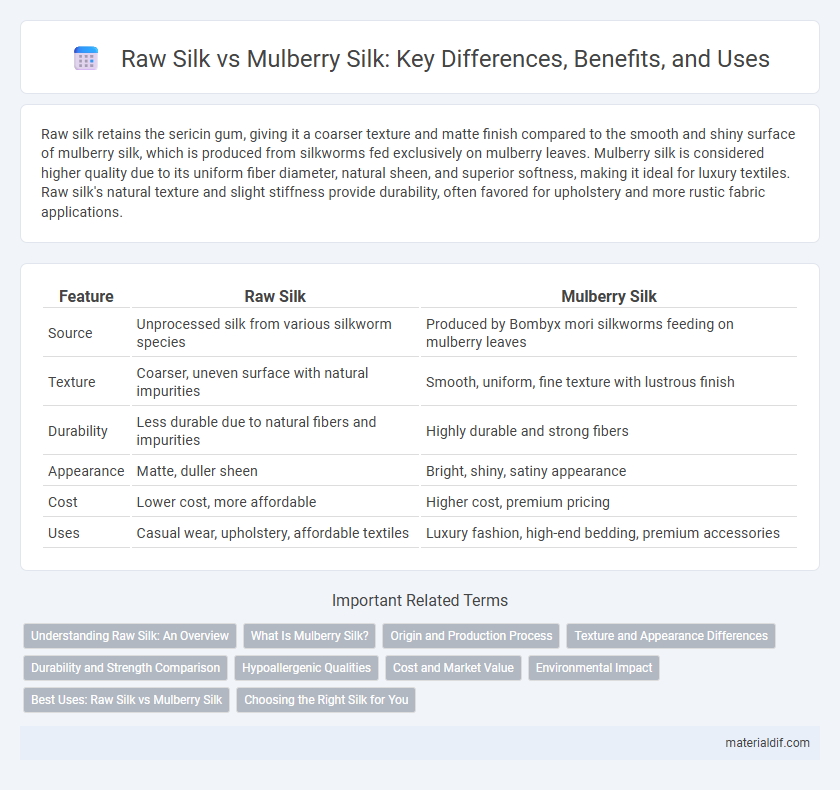Raw silk retains the sericin gum, giving it a coarser texture and matte finish compared to the smooth and shiny surface of mulberry silk, which is produced from silkworms fed exclusively on mulberry leaves. Mulberry silk is considered higher quality due to its uniform fiber diameter, natural sheen, and superior softness, making it ideal for luxury textiles. Raw silk's natural texture and slight stiffness provide durability, often favored for upholstery and more rustic fabric applications.
Table of Comparison
| Feature | Raw Silk | Mulberry Silk |
|---|---|---|
| Source | Unprocessed silk from various silkworm species | Produced by Bombyx mori silkworms feeding on mulberry leaves |
| Texture | Coarser, uneven surface with natural impurities | Smooth, uniform, fine texture with lustrous finish |
| Durability | Less durable due to natural fibers and impurities | Highly durable and strong fibers |
| Appearance | Matte, duller sheen | Bright, shiny, satiny appearance |
| Cost | Lower cost, more affordable | Higher cost, premium pricing |
| Uses | Casual wear, upholstery, affordable textiles | Luxury fashion, high-end bedding, premium accessories |
Understanding Raw Silk: An Overview
Raw silk consists of silk fibers that are produced directly from the cocoon without extensive processing, retaining sericin, the natural gum that binds the fibers. In contrast, Mulberry silk, derived from the Bombyx mori silkworm, undergoes degumming to remove sericin, resulting in a smoother, softer texture. Understanding raw silk highlights its unique characteristics such as greater strength and a natural sheen, distinguishing it from the refined mulberry silk used widely in luxury textiles.
What Is Mulberry Silk?
Mulberry silk, derived from the Bombyx mori silkworms that feed exclusively on mulberry leaves, is renowned for its superior quality and smooth texture compared to raw silk. It offers a higher tensile strength, uniform fiber thickness, and a lustrous finish, making it the preferred choice for luxury textiles and bedding. Unlike raw silk, which contains sericin and has a rougher texture, mulberry silk undergoes a thorough degumming process, resulting in a softer, hypoallergenic fabric ideal for sensitive skin.
Origin and Production Process
Raw silk is derived from silkworms that spin cocoons naturally, often incorporating sericin which gives it a coarse texture, while Mulberry silk originates from Bombyx mori silkworms exclusively fed on Mulberry leaves, resulting in finer, smoother fibers. The production process of raw silk involves less processing, retaining natural proteins, whereas Mulberry silk undergoes meticulous reeling and degumming to remove sericin, enhancing luster and softness. Mulberry silk's controlled cultivation and refined production method contribute to its higher quality and widespread use in luxury textiles.
Texture and Appearance Differences
Raw silk has a coarser texture and a slightly matte appearance due to the presence of sericin, while Mulberry silk offers a smoother texture and a natural sheen resulting from refined silkworm cultivation. Mulberry silk fibers are finer and more uniform, contributing to its soft, lustrous quality compared to the more textured and rugged feel of raw silk. These differences in texture and appearance largely influence their applications in luxury textiles and everyday fabric uses.
Durability and Strength Comparison
Raw silk retains sericin, making it coarser and less uniform but more durable due to its natural fiber coating that enhances resistance to wear and tear. Mulberry silk, derived from silkworms fed exclusively on mulberry leaves, features long, smooth fibers that provide superior tensile strength and a finer texture, although it is slightly less durable than raw silk. The natural sericin in raw silk contributes to its higher abrasion resistance, while mulberry silk excels in elasticity and softness, balancing strength with delicate feel.
Hypoallergenic Qualities
Raw silk contains sericin, a natural protein that may trigger allergies in sensitive individuals, while mulberry silk is highly refined and free from sericin, making it inherently hypoallergenic. Mulberry silk's smooth fibers resist dust mites, mold, and bacteria, contributing to its superior allergy-friendly properties. Choosing mulberry silk enhances comfort for those with skin sensitivities or respiratory issues.
Cost and Market Value
Raw silk is generally less expensive than Mulberry silk due to its coarser texture and less uniform quality, making it more affordable in the textile market. Mulberry silk, produced from silkworms fed exclusively on mulberry leaves, commands a higher price because of its superior softness, luster, and strength, driving greater demand in luxury and high-end fashion sectors. The market value of Mulberry silk remains consistently higher, reflecting its premium quality and extensive use in fine garments and upholstery.
Environmental Impact
Raw silk production often involves wild silkworms, resulting in limited control over environmental conditions, potentially leading to habitat disruption. Mulberry silk, derived from domesticated Bombyx mori silkworms fed exclusively on mulberry leaves, typically supports more sustainable and controlled farming practices with reduced pesticide use. Mulberry silk cultivation generally has a lower carbon footprint and less water consumption compared to raw silk production, contributing to its enhanced environmental sustainability.
Best Uses: Raw Silk vs Mulberry Silk
Raw silk, known for its coarse texture and natural sericin coating, is ideal for upholstery, home decor, and crafting projects where durability and a rustic aesthetic are desired. Mulberry silk, prized for its smoothness, luster, and hypoallergenic qualities, is best suited for luxury bedding, high-end apparel, and delicate accessories that demand softness and elegance. Choosing between raw silk and Mulberry silk depends on the balance between texture, strength, and intended use in textile applications.
Choosing the Right Silk for You
Raw silk retains sericin, offering a coarse texture and natural sheen, ideal for those seeking durability and a rustic aesthetic. Mulberry silk, produced from silkworms fed exclusively on mulberry leaves, provides a smoother, more lustrous finish with hypoallergenic properties, perfect for sensitive skin and luxury applications. Selecting between raw silk and mulberry silk depends on preferences for texture, durability, and intended use in textiles or apparel.
Raw silk vs Mulberry silk Infographic

 materialdif.com
materialdif.com